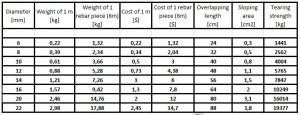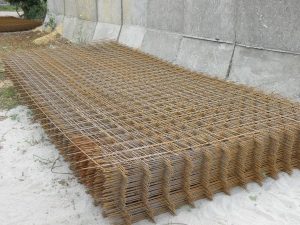Rebar – what is it good for?
Oh well, what is it not good for? I can show You tons of possibilities from bicycle building material to wife punishing tool, but the main task is to harden concrete structures. Of course, it has to be in the structure during the pouring. People call it rebar, but it’s made of iron, steel, etc... everyone knows what it is, it’s a rusty piece of ribbed wand, what can be found scattered on every construction site…

So the rebar has a big role in concrete technology: it multiplies the strength of a strip foundation, a concrete crown, or maybe a concrete block wall. I will show You the function through an example: if we dig some soil, and there are roots from some plants, it’s much harder to dig. Digging is easier if there are no roots. In this example, the roots are the steel rebars in the concrete, and they are hardening the structure. A bit more complicated: in a fine tuned concrete structure the concrete picks up the pressing forces, the rebars take the tensity (pulling) forces. The concrete is almost unable to withstand pulling forces, but it’s great for pressing forces. The steel is good at both forces, but it’s f*cking expensive, so it’s not economical to make foundations only from steel. So the sharp minded engineers invented this hybrid structure, where everyone does what it’s good for.
Rebar length
We can buy rebars in two main length: 6 m and 12 m. Of course, there are different sizes, but the most common is 6 m. The 12 m version in hard to move on the roads, and even in the construction site, so it’s not too common. The usual length is 6 m. We can make it shorter, with grinder. We can make it longer as well: we have to elongate it, with two overlapped pieces. The length of the overlapping is at least 40 times the diameter of the rebar. For example: if we have d= 8 mm rebars, the overlapping length is 8 mm X 40 = 320 mm (32 cm). This means, that the two rebars has to run by each other for at least 32 cm. This way You can make as long rebars as You want!
If it’s possible, don’t let the rebars to be welded. Welding weakens the material, and they can take less force. I can guarantee, that there will be some sharp minded underhand, who will be sure that welding will be just fine for You. He will tell You, that he has been doing it like this for years, and it’s perfect. The correct answer: don’t think too much, just don’t weld it together.
Rebar diameter

Diameter (d) is the most important dimension of a rebar. The thicker the rebar, the more iron is in it. The more iron can withstand more force. Of course, the more material means higher price. The price moves on around 1 $/kg.
In a normal everyday house we use only a few main sizes:
- d = 6 mm – this diameter is quite weak, but it might be good for rebar stirrups. It’s cheap, but it bends in every direction
- d = 8 mm – well, this is the good size for rebar stirrups. Also, we use it for reinforcing base plates with steel meshes
- d = 10 mm – this size is too big for stirrups, but too weak for main rebars. It is also good for reinforcing base plates with steel meshes
- d = 12 mm – this size is good for strip foundations, for the running rebars. It is also good for wreath building. Bending is still possible with manual re-bar bender
- d = 14 mm – this size is also good for foundations, concrete crowns, and You can bend it with a metal bender (with hand, not the machine)
- d= 16 mm – this size is good for reinforcing concrete beams. It’s hard to bend with metal bender by hand.
- d= 20 mm – this size is rare for house building, it can be used for large free span concrete beams. Very hard tho bend with metal bender by hand.
Strength
My grandpa always said: this is where the piss divides from the shit. On the upper chart I calculated the pulling power of each type of rebar. You can hang a car on even the crappy 6 mm diameter rebar, it will hold. If we lay for example 6 strips of d=12 mm reinforcing iron in our foundation, it will be able to take on 35 tons of pulling force. That is fuck-much! Of course, we can flush our money in the toilet, if we don’t install the rebars correctly, they will capitulate, and not work. The rebars can take pulling force of a bullock, but a faulty install will make them worth of a mosquito fart.
Oh, and one more thing: if it’s possible, use more small diameter rebars instead of a few big ones. The small diameter ones will work much better with the concrete, because they meet on a bigger surface. At the end the end price will be higher (both work+material), if we choose more thin rebars, but the result will be better!
Steel mesh

This is an interesting type of rebar: some are thin rebars welded together in a factory. With these steel meshes, we can easily make floors and slabs. The steel mesh is very useful, because it speeds up the construction, and saves us from bowing and binding. This way we can make the reinforce of 10 m2 in one sitting. The size of the mesh sheets are not normalized, this is the shame of the industry. The main size is 5 m x 2,15 m, this will cover about 10 m2.
Let’s see an example:
8 x 8 x 200 x 200 x 2150 x 5000 mm – nice, isn’t it? Yeah, just like a horse bite. This is how it works: the 8 x 8 at the beginning means that there is d= 8 mm rebar in both direction welded together. The 200 x 200 mm means that the rebars are welded with 200 mm spacing to each other (every direction). The 2150 x x 5000 mm shows the size of the whole rebar mesh. The elongation works with overlapping the sheets. The overlapped meshes have to be tied to each other, this way they won’t move during the concrete pouring. The size of the overlapping is calculated by the diameter.
Some conversant sizes with prices:
- 6x6x150x150x2150x5000 – 40 $ / sheet
- 6x6x200x200x2150x5000 – 32 $ / sheet
- 8x8x150x150x2150x5000 – 68 $ / sheet
- 8x8x200x200x2150x5000 – 57 $ / sheet
- 10x10x150x150x2150x5000 – 107 $ /sheet
- 10x10x200x200x2150x5000 – 86 $ / sheet
It’s simple to guess: the 150 mm square is stronger/more expensive , because it has more steel in it. Over d=10 mm diameter steel meshes are only produced for order (expensive), they are not used too often.
Overlapping of reinforcement bars

As mentioned before, we don’t weld the reinforcement bars together (it’s OK if it’s done in a factory, for example steel mesh factory). Then how do we add to the length of the bars? The answer is easy as a slap in the face: we use wire tie to fix the rebars for the concrete pouring. After that we hit it in the neck with some concrete. From then, they will behave like they have been sisters all the time. The wire tie in only needed until we pour the concrete on the rebars, so they won’t move. After that, they don’t work anymore…
I know two good methods for the wire tie:
- buy normal tieing wire in a big ring (black steel soft wire). Cut it into 15 cm pieces while it’s still in ring, and use some other wires to stabilize the pile. We use traditional cut nippers, or pincers to tie the wires. This is the peasant way.
- buy a w@nking robot seen in the picture (it’s a fast tie hand tool for winged wire) and some copper type wire. After that we use it like wanking the clown…
The first way is cheaper and slower. The second is cleaner, and faster (the tool is about 20 $, and the wire is cheap as well)
End line

You can make miracles with a nicely assembled concrete reinforcement: this miracle is the rare seen shooting star of the building industry, the normal, not cracked wall and concrete. The information above can give the people a good starting point for using rebars, and who isn’t afraid of getting their hand rusty, like the man in the picture. I tried to do the stunt after him, but I couldn’t heat our vice in the oven till melting…
The article can be found in Hungarian language!
Written by Levi

